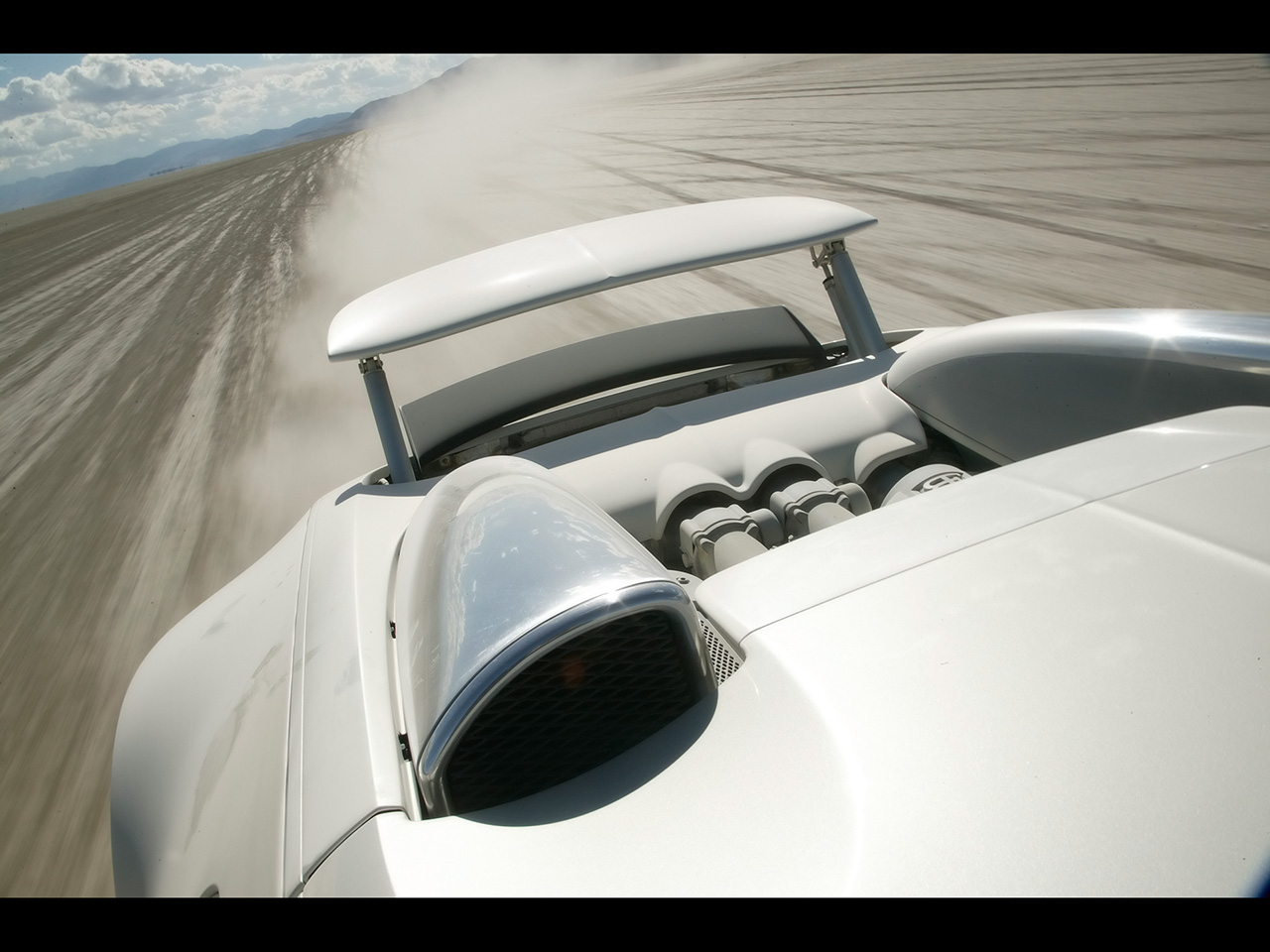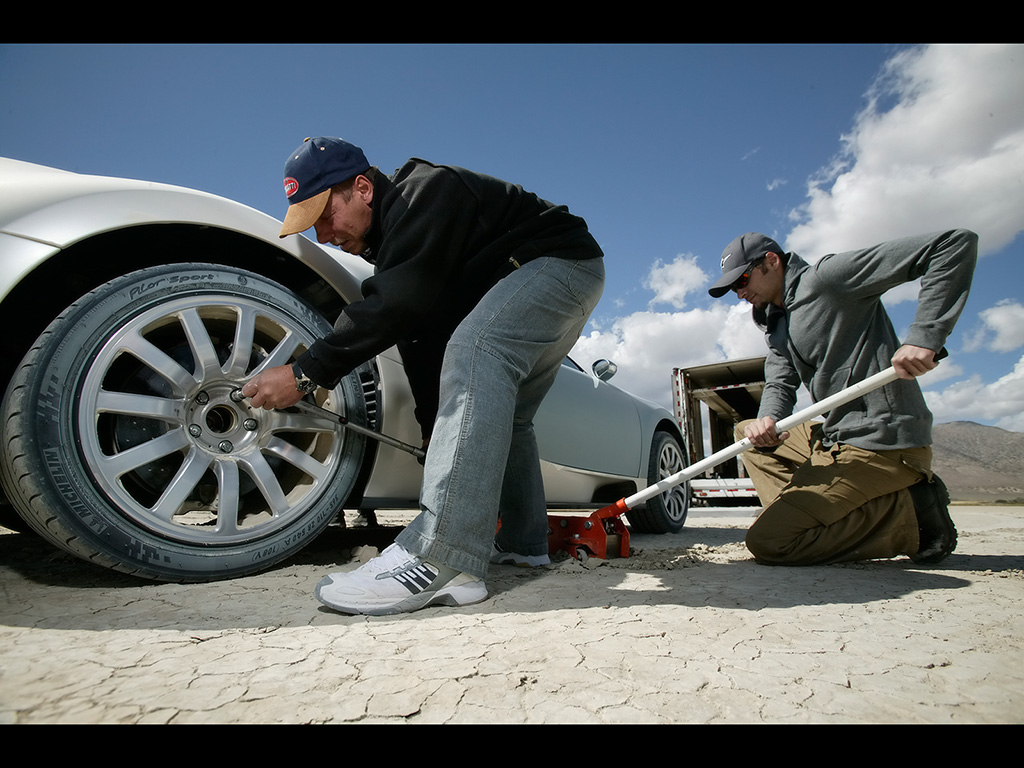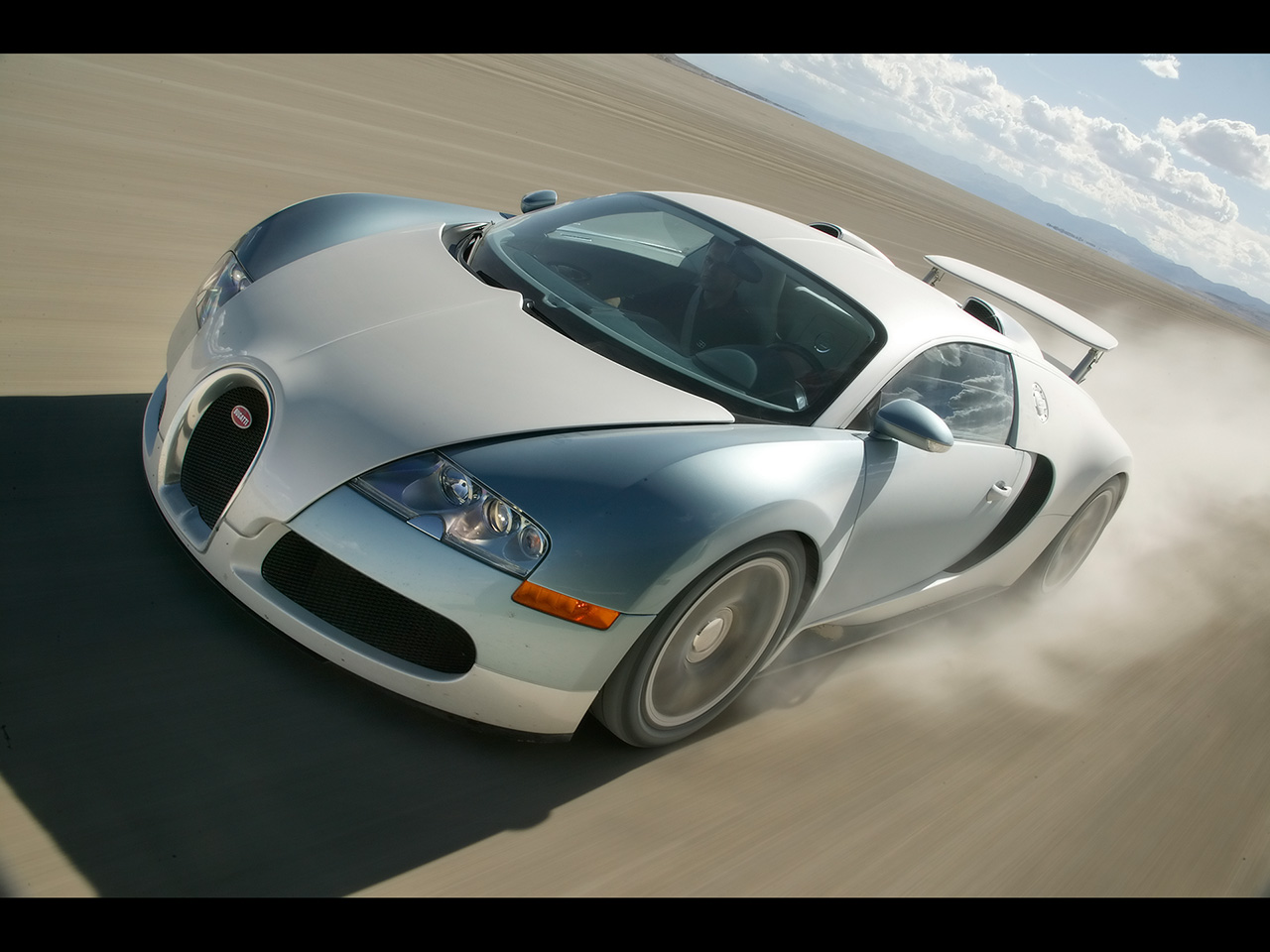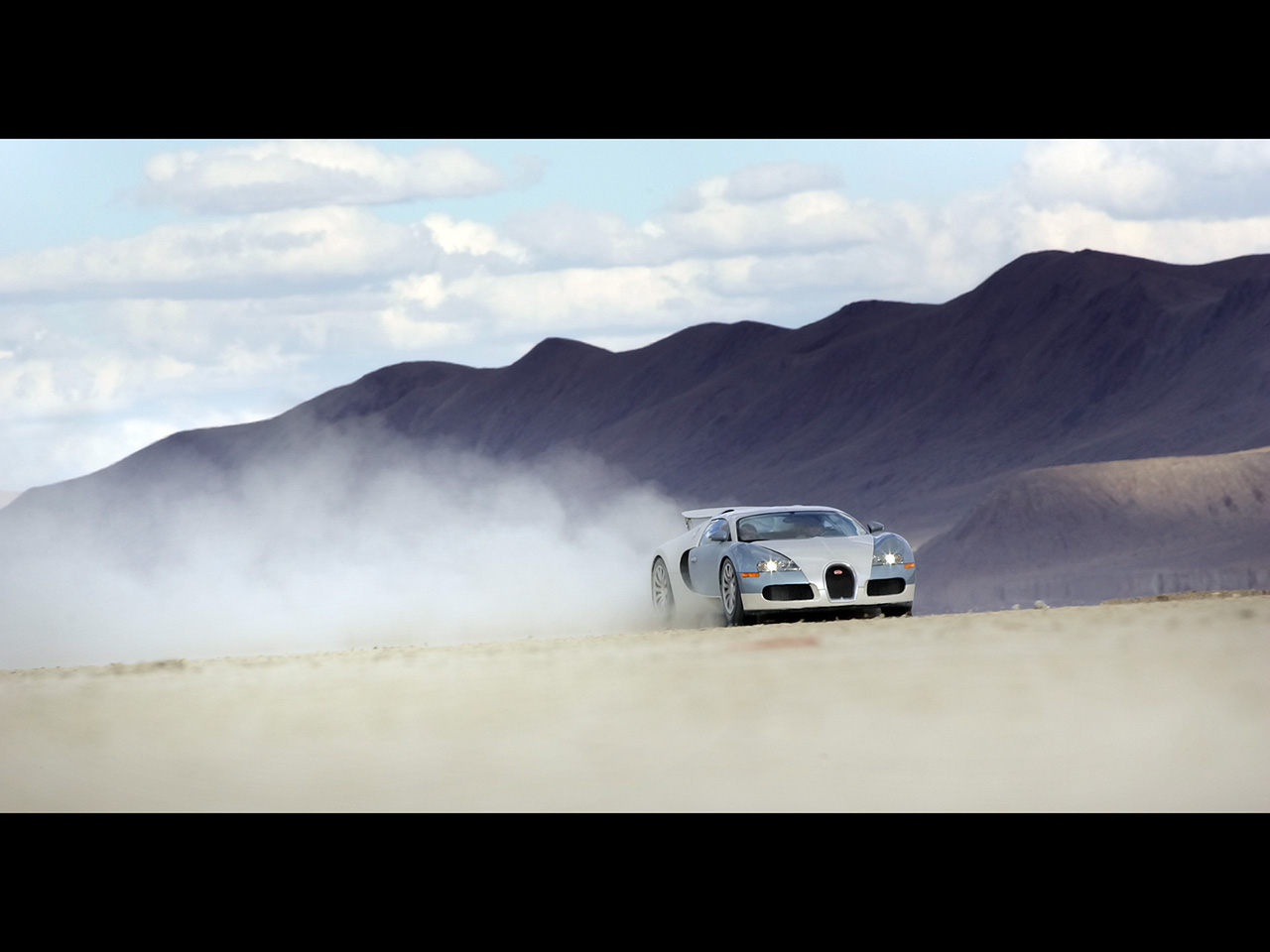2007 Bugatti Veyron
|
Price |
approx $1.2 million |
Production |
300 planned | ||
|
Engine |
8 liter W16 |
Weight |
4160 lbs | ||
|
Aspiration |
4 turbochargers |
Torque |
922 lb-ft | ||
|
HP |
1001 hp |
HP/Weight |
4.2 hp per liter | ||
|
HP/Liter |
125.1 hp per liter |
1/4 mile |
10.8 secconds @ 140 mph | ||
|
0-62 mph |
2.5 second |
Top Speed |
253.2 mph |
(from Bugatti Press Release) Over 60 Bugatti Veyron 16.4 delivered worldwide
Geneva 6th March 2007 _
by the end of February Bugatti Automobiles S.A.S. will have
delivered 60 Bugatti Veyron 16.4 to date. As a result, the planned
production volume has been exceeded.
After the start of production of the Bugatti Veyron in Alsatian
Molsheim at the end of 2005 and the delivery of the first vehicle in
March 2006, Bugatti Automobiles S.A.S. has reached the planned 50
units for the fi rst production year. This is interesting to note,
because the Bugatti Veyron 16.4 is a completely new model and thus
has not been able to rely on already existing components.
In December 2003, the responsibility for Bugatti Automobiles S.A.S.
went to Dr. Thomas Bscher, the new president of the company. Dr.
Wolfgang Schreiber was appointed as technical director and manager
of Bugatti Engineering. The entire Bugatti project was then
completely reassessed and a new schedule for the completion date of
the super sports car was decided. The objectives established in this
process have all been achieved since then.
Production of the Bugatti Veyron has been limited to a maximum of
300 units. The number of units for the fi rst production year has
amounted to – as announced – 50 vehicles. Today, Bugatti is already
able to increase the annual production volume and thus is able to
reduce the customer waiting time.
Promising order entry
“In 2007 we are planning
to increase the production of the Bugatti Veyron”, said Dr. Thomas
Bscher at the International Geneva Motor Show, “because the order
entry for the Veyron is getting close to a 140 and we wouldn’t want
our customers to have to wait longer for their Bugatti.”
“It is not unexpected”, continued Dr Bscher, “that most of the
orders come from the US; traditionally the most important market for
luxury vehicles. 30% of the 140 contracts received up to now with a
down payment of EUR 300,000, which is the condition for the
production of the vehicle to start, come from the United States.
This means that that is where – on a country basis – up to now most
of the Bugatti Veyron have been delivered.
In Europe, the majority of the demand comes from England and
Germany, which are the two most important markets for luxury cars
outside the US. Naturally, the Bugatti Veyron super sports car has
also created interest in the Middle Eastern countries and deliveries
to Arab countries underline the pleasant sales trend of this unique
vehicle.
A worldwide network of contract partners
Bugatti Automobiles
S.A.S. highly values supporting the vehicles sold with a worldwide
organisation of Bugatti bases. Within a year, a network of Bugatti
sales and service partners has been developed – now covering 26
locations. Consistent with the sales figures, the USA is also top in
this area with nine contact points. Five on the west coast, one in
Florida and the traditional areas in the east with three partners
sharing the responsibility. Also in Europe, the important luxury car
markets such as Germany, England, France, Monaco, Benelux, Austria,
Italy, Spain and Switzerland are already covered.
It goes without saying that the uniqueness of the Bugatti Veyron
16.4 has also not gone unnoticed in the so-called new markets. Thus,
increasing demand can be seen in China and Russia. As Bugatti has
set itself the goal of delivering only to areas where the company is
also represented by competent contact partners, these enquiries will
be treated with a certain level of caution until the development of
the sales and service organisation.
Old and new in Geneva
Today, the Bugatti
Veyron 16.4 already has its place in car history as an undisputed
classic. It embodies every-thing that is technologically and
technically possible in automobile construction on a level which is
absolutely unreached and will remain so for some time.
But also the Veyron models itself on the heritage and the value of
the brand. « Art – form – technique » the legacy of the company
founder is as significant today as in 1931 when the Type 55 was
created and one of these Type 55 models is shown at this year‘s
International Geneva Motor Show on the Bugatti stand. Thus, the link
between the “thoroughbred” of the 30s and the “pur sang” of the 21st
century will be highlighted in an impressive way.
The Type 55 Roadster
In 1931, the Type 55
replaced the Type 43 super sport tour car with a Grand Prix motor.
The Type 55 Bugatti now used the 2.3 litre Grand Prix motor with a
compressor from the Type 51 and the very stiff chassis of the Type
47 designed for a 16 cylinder motor. Thus it brought together
different ingredients to make one of the best Bugatti vehicles. The
brakes and tyres of the Type 55 were identical to those of the Type
51. The draft of the lovely two-seater roadster body offered by the
factory stemmed from Jean Bugatti. Apart from the roadster also the
so-called “Faux Cabriolet” was offered by the factory, a coupé whose
design also came from Jean. In total 38 chassis of the Type 55 were
manufactured between 1931 and 1935, 13 of them had the famous
roadster body shown here.
The acceleration of the Type 55 was amazing. From 0 to 100km/h in
under 10 seconds. Whilst steering and road holding around bends
convinced, many drivers wished for a gearbox like the Grand Prix one
instead of the sluggish Type 49 gear box. In 1933, a test journalist
wrote the following about the Type 55 in “Autocar”: “One doesn’t
expect an engine of this type to run noiselessly. Whilst the exhaust
noise of the car is noticeable but tolerable, there are a lot of
mechanical noises that are caused by the gear box and the closely
toothed wheels of the camshaft drive system. At high speed these
individual noises turn into a wild, impressive howl. Road holding
and handling are so excellent that one can zip around bends with the
car. As it doesn’t swerve one feels completely safe. For a car of
this type the suspension can be called comfortable…. Some experience
has to be used on the gear box, the first and second gear slightly
“hang” at high engine speed otherwise they can be changed quickly”.
More than any other Bugatti, the elegant Type 55 is a wolf in
sheep‘s clothing.
An international car
The new Veyron is an
impressive platform of top end automotive technology and – loyal to
Bugatti’s heritage « nothing is too expensive, nothing is too
beautiful » – only the best parts and materials in the trade are
used in the production process. And the Veyron is a truly
international car. One of the key- and most sophisticated parts, the
7 speed-sequential-DSG-double-clutch-gearbox, is made by motor sport
specialists Ricardo in the UK, the unique 16
cylinder-8.0-litre-engine comes from the Volkswagen engine plant in
Salzgitter in Germany.
The tyres – the first production tyres in the industry homologated
for speeds above 400 km/h – are a joint development with Michelin.
The carbon fibre mono coque is built by ATR in Italy, the front- and
rear-structure in forged aluminium by Heggemann in Germany and the
bespoke carbon-ceramic brakes by AP Racing in Great Britain. The
paintwork is German, the leather Austrian, the windscreen is
manufactured in Finland, and so it goes on.
50 years down the road, a car make once again
Today, nearly 50 years
later to the day, the production of Bugatti automobiles in Molsheim
is resuming, making Molsheim once again the hub of the Bugatti
world. As a centre for reminiscence, this picturesque, small city
near Strasbourg has never lost its signifi cance.
The area’s ‘Enthusiasts Bugatti Alsace’, together with their friends
in the various Bugatti clubs throughout the entire world, are in
large measure responsible for keeping the brand alive over the
decades – even in the absence of the product itself. This is an
experience, which various other prestigious automobile brands with
melodious names have not shared.
It is in this fact that the strength of the Bugatti brand values is
expressed most clearly. The admiration for ‘art on wheels’, the cool
achievement of the aesthetic tenacity of Ettore Bugatti, who was a
man who was fi rst and foremost an artist, not a technician. The
grandeur of the victories in the glorious years of dirt-encrusted
heroes on the racecourses of this world and, not least, the
suitability of these racing cars for everyday driving – the latter
is what made Bugatti cars accessible to a broader clientele. The
prestige of inspired design and the exclusiveness of individual
models that helped catapult certain Bugatti models into the
astronomical price classes.
In 1956, the final attempts had failed, in the wake of the death of
the company’s founder in 1947 – preceded in death in 1939 by his son
Jean, with whom he collaborated – to keep the substantially weakened
company alive. After 47 years’ production, in the course of which
7,950 Bugatti’s of models 13 through 251 had been manufactured, the
gates to the Bugatti factory in Molsheim were forced to close.



